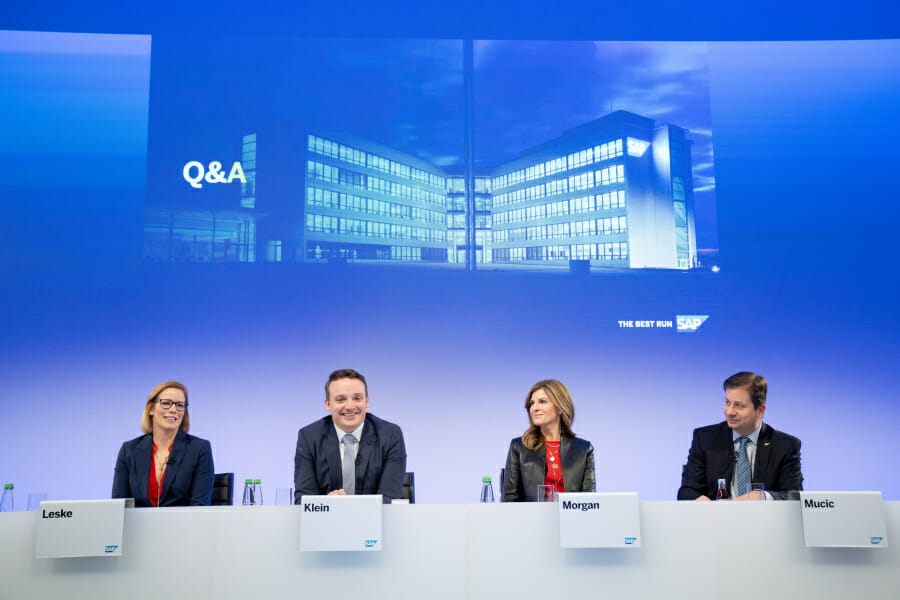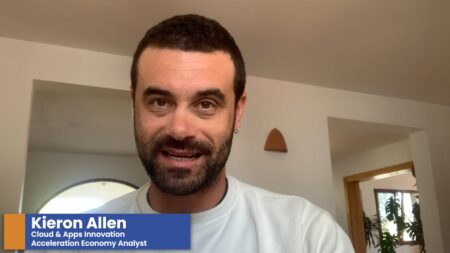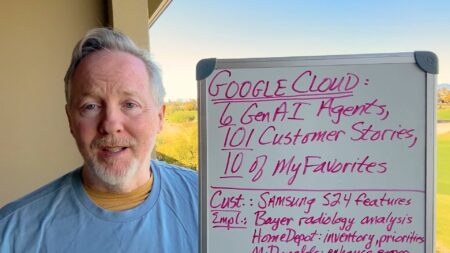Thirty-nine-year-old Christian Klein is now CEO of SAP, one of the most strategic and influential software companies in the world, on his own. His comments during this week’s Q1 earnings call offered some powerful insights into his thinking.
Klein’s in both a fabulous and a pretty darn tough spot.
Fabulous because he’s running a proud and powerful company with enormous influence across every industry on the planet.
Tough because it was only about 6 months ago that he and Jennifer Morgan were thrust unexpectedly into co-CEO roles. And also because it was only about 60 hours ago that Morgan decided to step down as co-CEO (we’ll dig into that decision at another time).
A reality check for SAP and new sole CEO Klein
So Klein is now sole CEO at SAP, a company that:
is navigating, like every other, the tumultuous and unprecedented impacts of COVID-19;
faces savage competition in every element of its business;
is still digesting a big acquisition (Qualtrics);
is still wrapping up its transformation to being primarily a cloud vendor; and
has undergone in just 6 months a series of jarring changes at the top of the company.
So against that backdrop, here are my 10 key insights into the thinking of Christian Klein, the new CEO flying SAP solo into its future.
1. SAP is all about—and I mean *all* about—the Intelligent Enterprise.
ERP put SAP on the map. It made SAP one of the most influential tech companies in the world and has powered and continues to power many of the biggest corporations in the world. Now, the new and improved S/4HANA is gaining serious momentum in both its cloud version and on-premises version. And Klein made it perfectly clear during the earnings call that Intelligent Enterprise, starring S/4HANA, is the one and only centerpiece of the company. Some relevant comments from Klein:
- “We are continuing to build the customer base and amidst this crisis. Indorama Ventures, one of the world’s leading chemicals companies, went all-in with the intelligent enterprise with S/4 in the core and surrounding applications to enable new business models, artificial intelligence and real-time analytics.”
- “Becoming an intelligent enterprise enables new business models and accelerates the move to the cloud.”
- “We saw around 500 customers go live on S/4HANA in Q1, underscoring our partners and our own remote service-delivery capabilities. S/4HANA Cloud continued to grow in the upper double-digits. Over the last month, we have significantly simplified migration and massively accelerated time to value and that has helped us to add live customers like Sun Life Financial, Hitachi High Tech and MTU Rolls Royce.
- “With S/4HANA on-premise for the larger projects, of course, we have seen some postponement of these projects. But also to be very clear, we talk about postponement, we are really sure that nothing of this business is lost—it’s postponed. But also there the good part of our strategy is that we give customer choice. So we have S/4HANA Cloud, where we still have seen double-digit growth in Q1 even in this crisis.”
- “Support is SAP’s largest and most stable revenue stream as evidenced in the 2008 and 2009 downturn. For most companies, shutting down SAP support would essentially mean shutting down their entire business.”
- “We saw a lot of customers now going for S/4HANA Cloud as there we can offer fast time-to-value… Plus we also have seen large corporations who went into an S/4HANA on-premises installation, but now because onsite work is quite difficult these days, they also changed the roadmaps to go with S/4HANA Cloud for certain subsidiaries, or for certain acquisitions.”
2. For SAP, customers’ digital transformations are inextricably linked with Intelligent Enterprise.
- “Companies need intelligence to deal with disrupted supply chains, restricted travel and the new ways of working. In short, only an intelligent enterprise can deal with uncertainty and rapid change.”
- “Digital transformation is no longer an option, it is essential. We are perfectly positioned to guide our customers through this journey and here’s why. Only SAP can enable new business models and digitize the entire value chain seamlessly end-to-end, making companies more resilient to cope with such a crisis. S/4HANA will help customers predict the demand and pipeline every minute, every day to dynamically adjust the supply chain. With Qualtrics we help customers navigate this fluid reality, gaining real-time insights into which behaviors are trending in a fast-changing environment where every day brings some more uncertainty. Our strong technology foundation with SAP Cloud Platform and SAP HANA allows us to integrate SAP and non-SAP applications, extend existing ones, and build new business applications. These are trends we can build upon.”
- “What we have seen in Q1 is actually that the customer buying behavior changed… So in the front office, clearly our customers have seen that those enterprises now have a competitive advantage who are already doing more online sales, who really worked on their omni-channel sales experience. Also downstream in the quote to cash, this was of course an area where a lot of customers now have chosen S/4HANA Cloud to change their business model into a pay-as-you-go subscription-based business model as a lot of enterprises these days have to overcome some liquidity challenges. And also then of course when you go further into the supply chain, we see now huge interest as customers realize that they have to build more-intelligent supply chains that Industry 4.0 requires with the automation of the digital factories.”
3. Despite the COVID-19 global slowdown, CEO Klein expects “rapid growth” in cloud.
- “We expect cloud revenue to continue with rapid growth in 2020 backed by the 25% expansion of the current cloud backlog.”
- “I see a lot of potential to grow our business organically as we didn’t even harvest all of our potential of the past acquisitions, the cross-sell opportunities. It’s not only Qualtrics: when you see still how many HCM on-premises customers we have in the installed base, and the same for CRM, we have a lot of potential. And I’m sure that with the current developments we have in play to really drive the integration, to really drive the modular suite, plus now also drive the verticalization of our solutions, to really go deeper into the industries as all of the industries are now changing these days, I’m sure we will see huge organic growth.”
4. The COVID-19 crisis has greatly accelerated SAP’s ability to do “hands-free” marketing, selling, provisioning and support.
In his opening remarks, Klein noted the results of a huge operational change within SAP. “Thanks to automated and intelligent processes, we were able to significantly increase our profitability,” he said. “As an example, we’re already winning 30% of our transactional volume via the SAP Digital Store with no-touch downstream processes.”
Later in the earnings call, Klein—SAP’s former COO—went into more detail.
From an operations perspective, we are building out our Digital Store capabilities. I find it really quite amazing that already 30% of our SME transactions are run by the Digital Store and then downstream with ‘no touch,’ meaning from the point of sale to the provisioning of the customer tenant, we need no human intervention anymore. Plus we also manage more and more of our renewals business via the store and now we are just expanding out our pay-as-you-go capabilities where customers can buy more consumption via the store again without any direct face-to-face intervention. And this is the type of automation, this is the type of intelligent enterprise our customers are driving for.
5. CEO Klein was emphatically clear: we will not cut funding for innovation or R&D.
As he made the case for SAP’s resilience and its advanced state of transformation during his opening remarks, the SAP sole CEO committed to maintaining the company’s current levels of investments in the future. He said: “We will not make unfavorable tradeoffs between 2020 profitability and future growth. Our customers have placed long-term trust in us, and they have every right to expect unchanged high levels of innovation from us. We won’t cut innovation and R&D.”
Klein underscored that later in the call by saying, “I already mentioned that we will double down on innovation.”
Cloud Wars
Top 10 Rankings — Apr. 20, 2020
| 1. Microsoft — Bogus “775% surge” went from fake news to lame fix—very surprising |
| 2. Amazon — Big donation of services to researchers for current and future crises |
| 3. Salesforce — Check out Marc Benioff: Extraordinary Ascendancy of a Global Leader |
| 4. Google — Kurian shares a massive, wide-ranging global response to COVID-19 |
| 5. SAP — Cloud to the rescue! Q1 cloud revenue 4.5X higher than new-license rev |
| 6. Oracle — New world: Larry Ellison makes Youtube video praising customer Zoom |
| 7. IBM — New CEO Krishna lays out strategy to beat Microsoft, Amazon, Google |
| 8. Workday — Bhusri doubles down on commitment to employees as crisis intensifies |
| 9. ServiceNow — McDermott sees ‘no layoffs’ and raises: hiring 1,000+ in 2020 |
| 10. Adobe — Digital Experience business up 24% to $859M in Q4 |
6. Klein is evangelizing the idea that ERP has come fully out of the ‘back office’ and is more relevant and strategic than ever before.
When you are SAP and you’re running the world’s most mission-critical business processes, clearly we could also have to put a lot of emphasis on integration and infusing intelligence in those business processes. And especially in times like these, when I talk now to many CEOs, but also to the public sector, I mean they now realize that ERP is more relevant than ever when these lockdowns happen, when the supply chains are getting disrupted. Suddenly we are having a very different kind of talk: we are not talking anymore about the backend ERP and only automating transactional processes. Now it’s about how you can react to fast-changing demands in the front office and pushing all that through the supply chain, which is highly resilient.
So I also actually expect that going forward our position will even be stronger as many of these CEOs now realize how important actually a well-working ERP really is—especially in times like this.
7. SAP’s future: from selling applications to helping orchestrate the massive power of data.
Klein also offered what sounded like a glimpse at Intelligent Enterprise 2.0. He said: “We at SAP have a unique opportunity to build one business network. We will connect our networks beyond our Intelligent Spend networks and utilize data to help our customers transform their traditional value-chain model to enable end-to-end visibility, collaboration, agility and optimization.”
8. As digital business becomes pervasive, Klein sees a big opportunity in vertical-industry solutions.
“In every industry, processes are affected by digital transformation. SAP traditionally was strong in vertically differentiating across industries. To run their value chains end-to-end, our customers want SAP to drive more vertical-industry-specific processes in the cloud with seamless integration to SAP Cloud solutions based on the SAP Cloud Platform. We will respond decisively to that demand.”
9. In Klein’s view, Qualtrics is as valuable as an enhancement to S/4HANA Cloud as it is as a standalone set of apps.
Former co-CEO Morgan opened up SAP’s Capital Markets Day last year by discussing the new opportunities in the Experience Economy with Qualtrics as its centerpiece. But Klein had little to say about Qualtrics beyond adding new capabilities to S/4HANA Cloud.
Since the end of last year, Qualtrics is already embedded with S/4HANA Cloud. So this gives us a complete new way of co-innovating with our customers because our end users now can give instant feedback about their experience with S/4HANA Cloud and our product managers can also then take real-time action on that. So this is a completely new way of doing co-innovation and definitely also then helps the innovation and adoption cycle of S/4HANA as we can translate that in our quarterly review cycles of S/4HANA Cloud.
10. SAP’s own digital transformation will allow it to emerge from the current global slowdown lean, fast and healthy.
“The current crisis shows that our intelligent enterprise strategy is more relevant than ever both for our customers and SAP. First, it leads to more-resilient digital-enabled business continuity. Our more than 400,000 customers worldwide make the world run, and we enable them to continue to do so. Thanks to our transformation into an intelligent enterprise, we can continue our operations without any disruption.”
Final thought
To be sure, Klein’s mentor, SAP co-founder and chairman Hasso Plattner, will keep close with Klein in the months ahead. Plattner’s always stayed fairly close to SAP’s CEOs, and no doubt Klein will welcome Plattner’s wisdom.
But Klein is flying solo now, and the future of a remarkable company—not to mention its 400,000 customers—is now in his hands.
RECOMMENDED READING
SAP, Oracle and Salesforce Agree on One Thing: co-CEO Model Is Dead
SAP Has Twice as Many Cloud ERP Customers as Oracle: Exclusive Co-CEO Interview
7,600 Companies Pounce on Free SAP Solution to Help Employees Manage COVID-19 Stress
SAP Q1: COVID-19 Guts License Sales but Cloud Revenue Jumps 29%
Marc Benioff: The Extraordinary Ascendancy of a Global Leader
Will IBM’s New CEO Shake Up the Company or Simply Shuffle the Pieces?
To Combat COVID-19, a Retail App Becomes a ‘Smart Quarantine’ Solution
Google Cloud Unveils Massive, Wide-Ranging Global Response to COVID-19
Subscribe to the Cloud Wars Newsletter for in-depth analysis of the major cloud vendors from the perspective of business customers. It’s free, it’s exclusive and it’s great!







